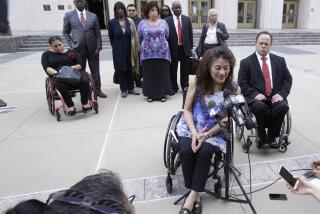Providing Easier Access
Accolades to Joanna Arhon, who wrote (“More Help Needed for the Disabled,” June 9) describing the observation of a disabled person unsuccessfully “reaching out and touching someone” because a public telephone was installed at an inaccessible height.
The Americans With Disabilities Act of 1990 signed by President Bush requires that newly designed or constructed buildings and facilities be “accessible.” Altered portions of existing buildings are also required to conform to these guidelines.
California adopted many of the civil requirements of ADA in its issuance of California Title 24 (State Building Code) in 1993.
While the intent is to provide equal facilitation, opposition still exists. Many building owners, developers and managers have been wary of updating key features of their buildings because of the expenses related to retrofitting the noncomplying areas. These features may be off-site and include access to parking areas as well as public transportation drop-off points.
Other areas greatly affected include parking areas, building entries, stairs, ramps, handrails, elevators, public telephones, water fountains and restrooms. Many times the expenses associated with upgrading these features are great in relation to the area that is under development.
Finally, the state and federal codes may at times appear confusing, contradictory and ambiguous. Although they were written and adopted to provide an environment that is accessible to the disabled, adhering to the requirements is no simple task.
The design professional is responsible for promoting an environment that provides the best facilitation possible when designing new facilities or renovating existing facilities. Sometimes, though, it may appear that “equal facilitation” has not been accomplished when, in reality, based upon the previous existing condition, a clear intent of compliance is established.
In some cases, it is not possible to achieve “accessibility” as Arhon has observed.
LOREN J. DELLAMARNA
Newport Beach
More to Read
Sign up for Essential California
The most important California stories and recommendations in your inbox every morning.
You may occasionally receive promotional content from the Los Angeles Times.










